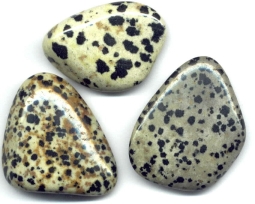This speckled rock in black and white, which was named after the Dalmatian dog breed, was long thought to be a porphyrite (a volcanic rock). Also other speculations about the mineralogical composition and formation of this rock, ranging from a volcanic porphyrite to a rock with black tourmaline, were not scientifically proven.
Reason enough for the EPI laboratory to take a closer look at this rock. Even the first analyses of the microstructure led to the assumption that this stone could be a gangue rock. To verify this assumption, it was necessary to precisely determine the mineral composition of this rock. Of particular interest was the way of formation and the nature of the black spots. Therefore we first tried with Raman laser analysis to find out what these black spots consist of. The analyses proved that the black spots cannot be tourmaline, but a mineral from the amphibole group. Since this group is extremely diverse and has numerous solid solution members, no precise conclusions could be optained from the Raman spectrum.
A petrographic thin section analysis finally provided the necessary information to characterize this rock more precisely. At 40x - 200x magnification it got clear, that the black spots from which the rock owes its name consist of tiny black crystal aggregates with a poikiloblastic structure. Such structures are formed when minerals are growing so fast, that numerous other smaller minerals are incorporated in the crystal. The dark areas could be optically determined as ferro-riebeckite. The light minerals could be identified as quartz and feldspars. The feldspars consist mostly of albite (sodium feldspar), but also some microclinic (potassium feldspar) is present.
Thus it was clear that the Dalmatian stone is neither a jasper nor a porphyrite, but indeed a gangue rock, called "aplite" in mineralogy. Aplites are white to light-grey, fine-grained gangue rocks, which consist predominantly of feldspar and quartz. They are formed during the rapid cooling of a residual melt in the rupturing fissures of a cooling magmatic body.
Conclusion
On the basis of Raman and thin section analyses the Dalmatian stone could be identified as a very fine-grained, aplitic rock of granitic composition with a clear sodium predominance. The main mineral composition of this rock consists of quartz, feldspar (albite, microcline) and amphibole (ferro-iebeckite).
Since this rock definitely does not contain jasper, the trade name "Dalmatian Jasper" is misleading. The correct designation is: Dalmatian Stone (Aplite).




